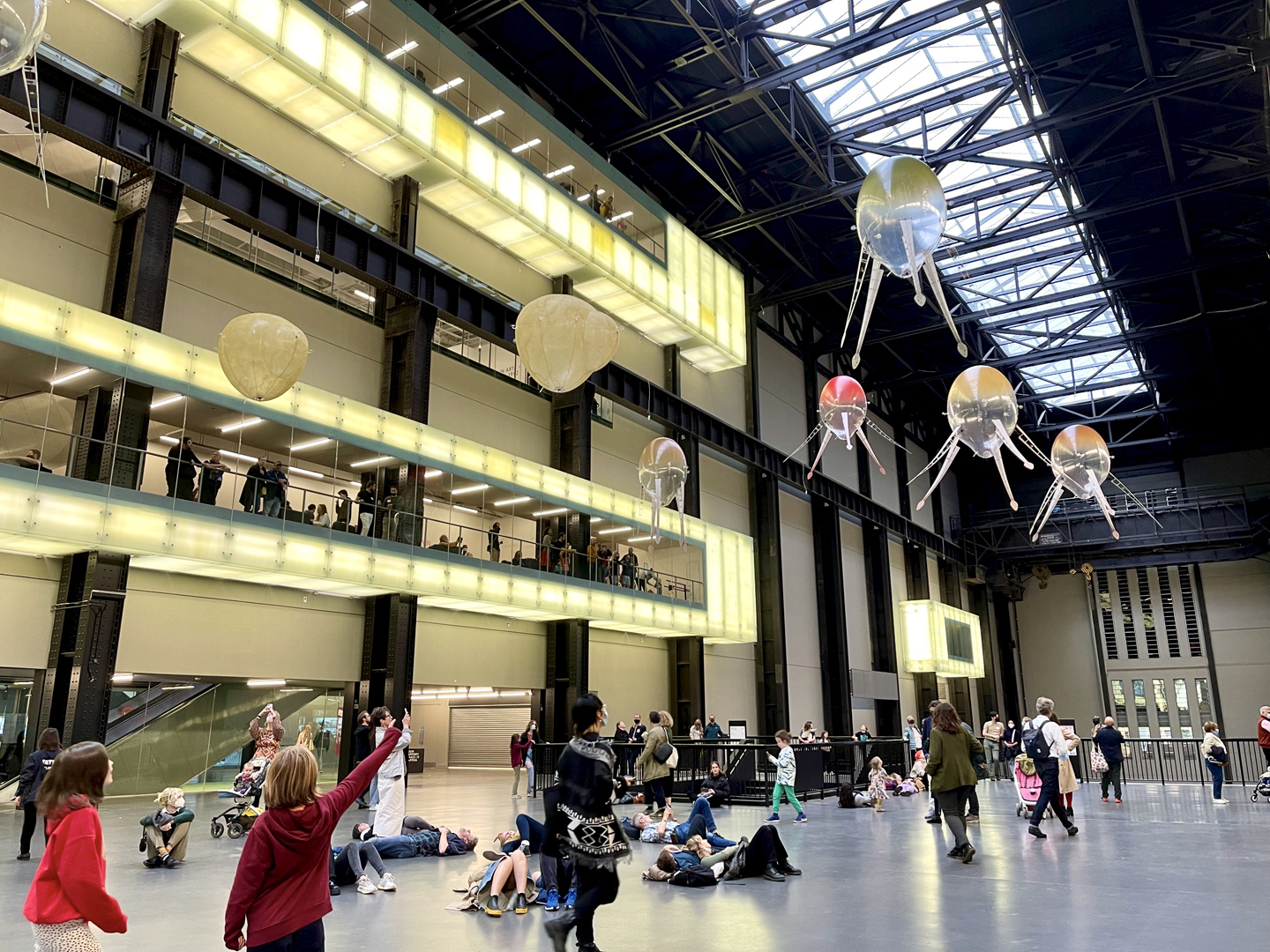“An Aquarium of Machines: A Physically Realized Artifical Life Simulation” by Lachenmyer and Akasha
Conference:
Type(s):
Entry Number: 02
Title:
- An Aquarium of Machines: A Physically Realized Artifical Life Simulation
Presenter(s)/Author(s):
Abstract:
This paper describes the public art installation In Love With The World by artist Anicka Yi, which embodies a complex virtual ecosystem of autonomous agents in a physical space. The agents, called Aerobes, are inspired by the lifecycle of the Aurelia sp. jellyfish, and use artificial life techniques designed by the authors to simulate the behavior of two distinct phenotypes. These agents are embodied in the Tate Modern’s Turbine Hall using lighter-than-air soft robotics utilizing helium that can respond to museum visitors through sensors embedded in the space. By creating organic-looking fully autonomous agents that are capable of real-time interaction, we hope to create an experience that causes viewers to question what living with machines might feel like in a speculative far-future, and to imagine an alternative form of artificial intelligence that is neither threatening to humanity nor subservient to it, but exists in an altogether parallel track as a new form of life.
References:
David J. Albert. 2011. What’s on the mind of a jellyfish? A review of behavioural observations on Aurelia sp. jellyfish. Neuroscience and Biobehavioral Reviews 35, 3 (2011), 474–482. https://doi.org/10.1016/j.neubiorev.2010.06.001Google ScholarCross Ref
Michael A. Arbib. 1992. Schema Theory. In The Encyclopedia of Artificial Intelligence (2nd ed.), Stuart C Shapiro (Ed.). Number January. Wiley-Interscience, USA, 1427–1443. https://dl.acm.org/doi/book/10.5555/122836Google Scholar
Ronald C. Arkin. 1987. Motor schema based navigation for a mobile robot: An approach to programming by behavior. In Proceedings. 1987 IEEE International Conference on Robotics and Automation, Vol. 4. Institute of Electrical and Electronics Engineers, 264–271. https://doi.org/10.1109/ROBOT.1987.1088037Google ScholarCross Ref
Ronald C. Arkin. 1989. Motor Schema — Based Mobile Robot Navigation. The International Journal of Robotics Research 8, 4 (1989), 92–112. https://doi.org/10.1177/027836498900800406Google ScholarCross Ref
Randall D. Beer. 1990. Intelligence as adaptive behavior : an experiment in computational neuroethology (first ed.). Academic Press. 240 pages. https://doi.org/doi.org/10.1086/418506Google Scholar
Bruce M. Blumberg and Tinsley A. Galyean. 1995. Multi-level direction of autonomous creatures for real-time virtual environments. In Proceedings of the ACM SIGGRAPH Conference on Computer Graphics. ACM, 47–54. https://doi.org/10.1145/218380.218405Google ScholarDigital Library
Valentino Braitenberg. 1984. Vehicles: Experiments in Synthetic Psychology. MIT Press, Cambridge, MA. 168 pages.Google Scholar
Robert Burke, Damian Isla, Marc Downie, Yuri Ivanov, and Bruce Blumberg. 2001. Creature Smarts: The Art and Architecture of a Virtual Brain. IN PROCEEDINGS OF THE COMPUTER GAME DEVELOPERS CONFERENCE (2001), 147–166. https://doi.org/10.1.1.11.1968Google Scholar
Janja Ceh, Jorge Gonzalez, Aldo S. Pacheco, and José M. Riascos. 2015. The elusive life cycle of scyphozoan jellyfish – Metagenesis revisited. Scientific Reports 5, 1 (jul 2015), 1–13. https://doi.org/10.1038/srep12037Google ScholarCross Ref
Kate Darling. 2021. The new breed : what our history with animals reveals about our future with robots (first ed.). Henry Holt and Co. 336 pages.Google Scholar
J. A. M. Frederiks. 1969. Disorders of the body schema. In Handbook of Clinical Neurology, G. Bruyn and P. Vinken (Eds.). North Holland, 4–207. https://philpapers.org/rec/FREDOTGoogle Scholar
Ruairi Glynn. 2015. Morphs 2.0. http://www.ruairiglynn.co.uk/portfolio/morphs-2-0/ Accessed 2022-04-18.Google Scholar
Pattie Maes. 1993. Modeling Adaptive Autonomous Agents. Artificial Life 1, 1-2 (jan 1993), 135–162. https://doi.org/10.1162/artl.1993.1.135Google ScholarDigital Library
Wayne McGregor. 2017. +/- Human. https://waynemcgregor.com/productions/plusminushuman Accessed 2022-01-15.Google Scholar
Marvin Minsky. 1988. The Society of Mind. Simon & Schuster. 336 pages. https://doi.org/10.5555/22939Google ScholarDigital Library
Jean Piaget. 1972. Biology and knowledge : an essay on the relations between organic regulations and cognitive processes. Quarter Review of Biology 47, 2 (1972), 384. https://doi.org/10.1086/407227Google Scholar
Craig W. Reynolds. 1987. Flocks, herds, and schools: A distributed behavioral model. In Proceedings of the 14th Annual Conference on Computer Graphics and Interactive Techniques, SIGGRAPH 1987. Association for Computing Machinery, Inc, 25–34. https://doi.org/10.1145/37401.37406Google ScholarDigital Library
Craig W Reynolds. 1988. Not bumping into things. In ACM SIGGRAPH Course 27 Notes: Developments in Physically-Based Modeling. ACM Press, G1-G13. https://doi.org/10.13140/RG.2.2.12202.62407Google Scholar
C. W Reynolds. 1999. Steering behaviors for autonomous characters. Game Developers Conference (1999), 763–782. https://www.red3d.com/cwr/steer/http://citeseerx.ist.psu.edu/viewdoc/summary?doi=10.1.1.16.8035Google Scholar
Adam Runions, Martin Fuhrer, Brendan Lane, Pavol Federl, Anne-Gaëlle Rolland-Lagan, and Przemyslaw Prusinkiewicz. 2005. Modeling and visualization of leaf venation patterns. (2005), 702. https://doi.org/10.1145/1186822.1073251Google ScholarDigital Library
Christa Sommerer and Laurent Mignonneau. 1999. Life Spacies. ACM SIGGRAPH 1999 Conference Abstracts and Applications, SIGGRAPH 1999 (jul 1999), 170. https://doi.org/10.1145/311625.311966Google ScholarDigital Library
Kingsley Stephens, Binh Pham, and Aster Wardhani. 2003. Modelling fish behaviour. In Proceedings of the 1st International Conference on Computer Graphics and Interactive Techniques in Australasia and South East Asia, GRAPHITE ’03. 71–78. https://doi.org/10.1145/604471.604488Google ScholarDigital Library
Naoko Tosa. 1993. Neuro Baby. https://digitalartarchive.siggraph.org/artwork/naoko-tosa-neuro-baby/ Accessed 2022-04-18.Google Scholar
Xiaoyuan Tu and Demetri Terzopoulos. 1994. Artificial fishes: Physics, locomotion, perception, behavior. In Proceedings of the 21st Annual Conference on Computer Graphics and Interactive Techniques, SIGGRAPH 1994. Association for Computing Machinery, Inc, New York, New York, USA, 43–50. https://doi.org/10.1145/192161.192170Google ScholarDigital Library
Sun Yuan and Peng Yu. 2016. Can’t Help Myself. https://www.guggenheim.org/artwork/34812Google Scholar




